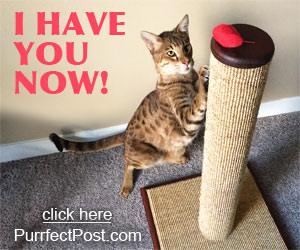Clicker Training for Cats: Come When Called

One of the most desirable things that your cat can do is to come when you call for her. It is highly likely that she has already learned to come when she hears the can opener or the treat can but, unless you can emulate that sound, you will need to come up with an alternative cue.
Cats cannot be forced into doing anything. The more you attempt to coerce them, the more they will wish to escape the situation.
A cat must want to perform a specific behavior before you can teach her to do so on command. Therefore, the reward for that performance must be highly motivational so that she will want to repeat the behavior over and over again.
Clicker training can enhance your feline's performance by informing her when she did something you liked so that she knows the reward is on its way.
Motivate Your Cat to Respond to Training
Before you can train your cat to perform anything, you must discover what will make her want to work for you. Many cats will do anything for canned food or tuna. Some cats prefer treats. Then there are those cats that could care less about food rewards but a special toy will get them moving.
Pair an Action with a Sound
Begin the training by teaching your cat the meaning of the click sound.
- Put your cat's reward on a spoon (so your fingers are safe).
- Allow her to see and sniff the spoon, then click and let her have the food or play with the toy for a few moments.
- Repeat this three to five times.
- Move the spoon a little to the left or right and, when your cat follows the spoon, click and allow her to eat or play with her reward.
Now that your cat understands the meaning of the click, we can progress to teaching her to come when called. (You can also target train your cat at this point, if you like. Target training is explained fully in this article.)
Come, Kitty
Always begin training with small steps.
Your cat will not automatically understand to come running from long distances unless you first teach her to come to you from a foot away.
- Put the spoon with the treat near your cat's nose. When you have her attention, draw the spoon toward you.
- As your cat follows the spoon, give a verbal cue such as "Here Kitty" or "Kitty, Come" using an enthusiastic tone of voice. Click when she arrives, then allow her to have some of her reward.
- Repeat these steps from a short distance, at least three to five times.
- Once she's reliably coming from a foot away without you having to draw her along with the spoon, increase the distance a little bit.
- Repeat these steps, beginning further and further away from your cat as she is successful at each increasing distance.
You will discover that your cat learns very quickly, and it won't be long before you're able to have her come to you from across the room.
Be sure to be timely with your click and reward. Once motivated, cats respond very quickly and need to be informed of their success immediately.
Limit your training sessions to five or six repetitions, and stop the training session if your cat acts disinterested or frustrated. Simply try again later.
Never attempt to use punishment as a way to train your cat. This will lead to fear, hiding, or aggression and possibly other negative behaviors.
You May Also Like These Articles:
Clicker Training for Cats: An Overview
How to Train Your Cat to Let You Sleep
Training Your Cat To Stay Off The Kitchen Counter
Clicker Training for Cats: Sit
How to Train Your Cat to Walk on a Leash
Notice: Ask-a-Vet is an affiliated service for those who wish to speak with a veterinary professional about their pet's specific condition. Initially, a bot will ask questions to determine the general nature of your concern. Then, you will be transferred to a human. There is a charge for the service if you choose to connect to a veterinarian. Ask-a-Vet is not manned by the staff or owners of CatHealth.com, and the advice given should not delay or replace a visit to your veterinarian.






